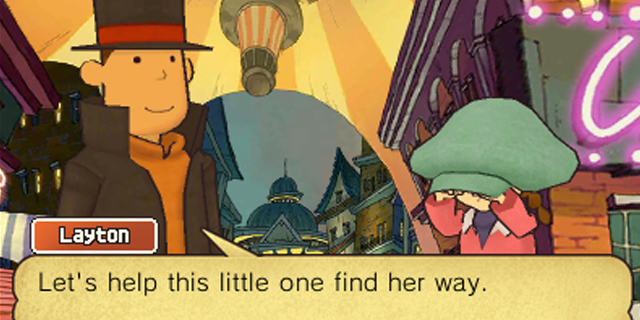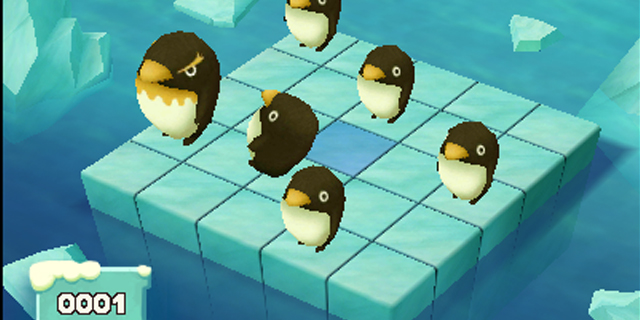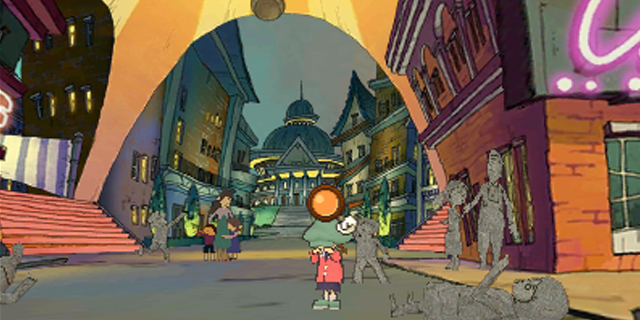
Have you played any of the previous four Professor Layton games? Yes? Then you know exactly what to expect here. Thanks for reading!
If you haven’t played any of them yet, think of them as a collection of puzzles (135 in the main narrative, optional downloadable unlocks, a few mini-games and, if you’re good enough at the latter, 15 incredibly difficult bonus puzzles) hidden amongst the scenery and population of a whimsical adventure starring the London gentleman and archaeology professor Hershel Layton, his young apprentice Luke Triton and, returning from Last Specter, research assistant Emmy Altavia. The details of each narrative differ from title to title, but they all involve a bunch of mysteries (many apparently supernatural in nature) that the Professor and company will have to work out as they progress. Along the way, they will encounter a variety of bizarre characters, almost all of whom will eventually force them to solve some sort of puzzle for whatever random reason.
These puzzles could be basically anything: mazes, logical deductions, riddles, mathematical word problems, difference-spotting, insidious sliding blocks. The list is pretty much endless, although you can expect to encounter a few specific ones at harder difficulties as the story progresses. If you get stuck, you can spend some Hint Coins that you’ve discovered in your travels to get increasingly helpful clues (for increasing costs, naturally), and completing the puzzle will earn you “picarats” equivalent to its difficulty minus a proportional amount for any wrong answers you submitted prior to getting it right. These picarats are only used for unlocking bonus content (like profiles, audio tracks and animated cutscenes), so don’t sweat them too much.

The puzzles, another take: The puzzles in Miracle Mask are still mind-twistingly tricky and give a great sense of accomplishment when solved, so if you have liked any title in the series thus far, you’re sure to like the new game, as well.
Level-5 has yet to stagnate on its creativity, however. Save for a few broad recurring archetypes, all the puzzles are original and fresh, which is quite the feat, considering the number of them across all the games, not to mention the bonus downloadable puzzles. – Chris Dominowski
The specifics of Miracle Mask‘s story involve a masked gentleman causing chaos in a resort town of Monte d’Or, and dovetails with a pivotal-yet-tragic chapter from the Professor’s youth that you will also experience (the chapters tend to alternate between the two stories). You can probably guess where everything is going before the characters actually get there, but by the end, there will be plenty of surprises lurking for even the most trope-savvy player and, in a refreshing change of pace, no completely insane last-minute twists. Well, okay, maybe one, but comparatively it’s nowhere near the utter nonsense the franchise has thrown at us in the past.
This is the first Layton installment on the 3DS, and as such the interface has been significantly altered from previous editions. Instead of pecking away at the touch screen looking for Hint Coins, puzzles and objects of interest, instead you use your stylus to direct a context-sensitive cursor on the upper screen. When the cursor hovers over something you can investigate, it turns orange and makes a sound, at which point you tap the screen to interact. This nicely avoids a ton of randomly stabbing at suspicious parts of the scenery hoping to discover something, and is thus a welcome change. The environments look excellent with or without the 3D on, although many have multiple layers that really pop when using it, and on a few you can actually zoom in to discover new areas when the cursor changes to blue.
What didn’t make the transition to 3D quite so well are the character designs, although the main trio’s tendency to point directly at you when successfully solving a puzzle is indeed at its full glory here. The Layton franchise has always had some bizarre character models, but when safely confined to 2D animation, you just kind of gloss over how weird some of them are, because part of your brain expects cartoons to be a little off. But when those same outlandish designs are transformed into 3D models, the effect can be quite jarring, if not downright hideous. Each interactive character has both models, with the 2D ones being used to fit them into the environments and the 3D ones coming into play as the characters converse. The series’ trademark animation scenes are mercifully kept to 2D, although the 3D effect makes them look even nicer than they already did.

Some puzzle controls are also affected by the shift to 3D, although no puzzle relies on it. One type of repeated puzzle involves you moving a hammer-shaped cursor by dragging and swinging it by tapping, which resulted in a few accidental swings that I didn’t intend, but other than that everything is smooth and several other puzzles use this same type of scrolling to excellent effect. You can move the puzzle’s text to the upper or lower screen (or hide it completely) as necessary, and the highly useful memo feature returns (often dragging the image on the top screen down so you can write “on” it more effectively) although it has lost the multiple colors from previous editions. Long-time Layton fans who stuck with this review after the opening paragraph will probably be relieved to note that there are only a handful of sliding block puzzles this time around, and a much healthier mix in general, with most repeats only getting two or three iterations instead of four (or seven, in some cases).
In one last 3D oddity, Level-5 abandons the usual point-and-click style interface for one chapter and thrusts Layton into a top-down adventure reminiscent of early Zelda games, featuring about a dozen boulder-rolling puzzle rooms and a few filled with dangerous mummies to evade in addition to some of the more traditional puzzles hidden along the way. This chapter is certainly different, but with one exception that uses somewhat real-time action still feels like typical Layton puzzling. I can’t help but wonder if we’ll see a return to this style in the next (and supposedly final) installment of the franchise.
Finally, while there is no “London Life” this time around, a major change has been made to the downloadable puzzles. Instead of one new puzzle a week, Miracle Mask offers a stunning one puzzle every day. You can download them in batches, so don’t worry about having to check in every day for the next year. This brings the total number of puzzles available in the game to well over 500 before everything is said and done, which is a phenomenal value.
What I stated in the opening to this review holds true: Miracle Mask is more of the same stuff that we’ve got over the previous Layton games, just prettied up a little (and uglied up, depending) for 3D. If you’re not tired of it yet, you won’t be. If you didn’t like the others, you won’t like this one. If you haven’t experienced Layton yet, this is as good a place to start as any.
Pros: Crazy amount of puzzles thanks to “Daily Download”, minigames and the actual content of the game
Cons: Layton character models were never meant to be realized in three dimensions



















